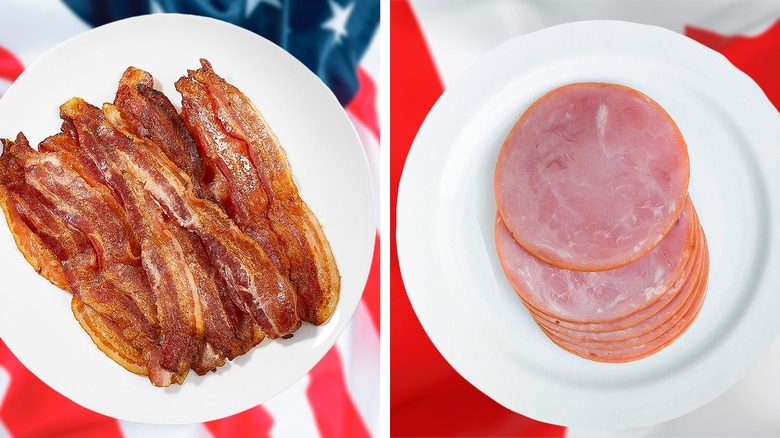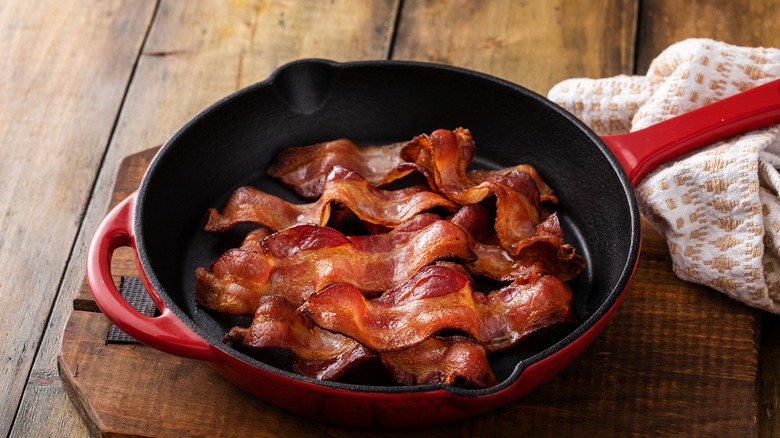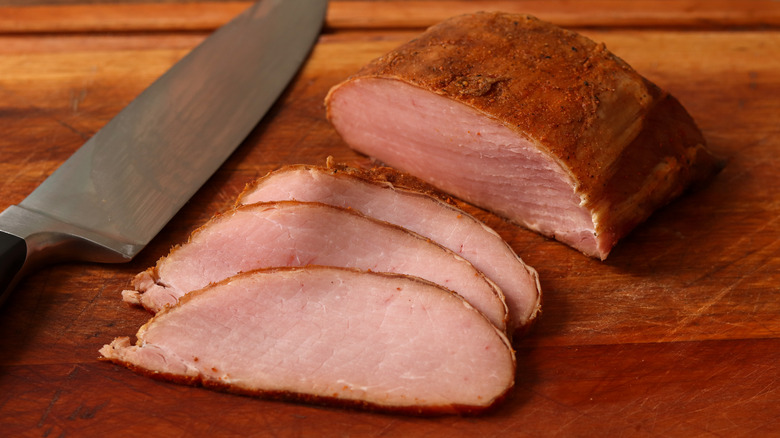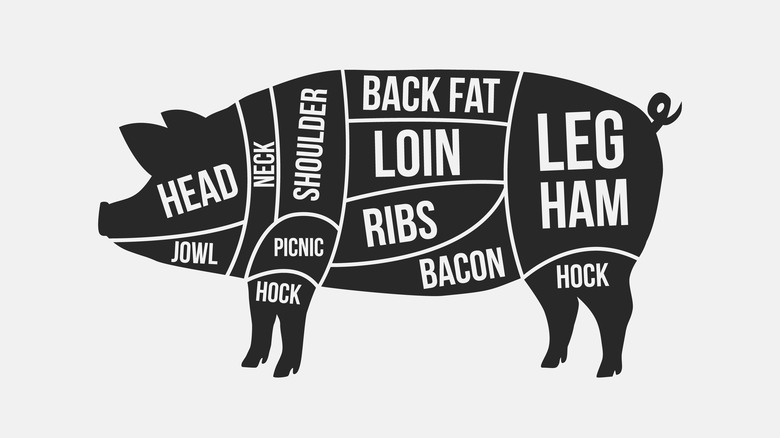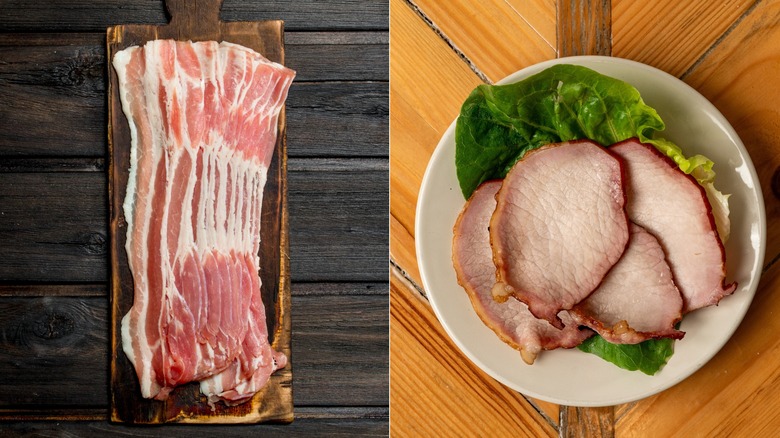The Difference Between American Vs Canadian Bacon
You don't need us to rave about bacon's salty and savory greatness. One of the most versatile cuts of meat, seemingly countless bacon recipes exist highlighting its deliciously crispy texture and umami-rich profile. While most of us are intimately familiar with the American style of this salted pork product, there are numerous types of bacon among the world's myriad cuisines — including the equally delicious yet distinct variety known as Canadian bacon.
There are a number of features that set Canadian bacon apart from American bacon. For starters, Canadian bacon is visually different from its American counterpart, so it's highly unlikely you'll ever get the two mixed up. Each type is also taken from separate parts of the pig, which influences the texture and fat content. Furthermore, bacon is typically processed differently north of the border, which affects the flavors of each bacon variety, as well as the way you need to prepare them for a recipe.
Of course, if you understand what differentiates these two popular types of bacon, you'll have even more ways to boost your culinary repertoire with bacony goodness. Let's take a closer look at the difference between American bacon and Canadian bacon.
What is American bacon?
American bacon is the most common variety you'll find in the U.S. It's taken from the belly of the pig, comes in long, thin strips, and is marbled with white, fatty streaks down its length. American bacon is cut exceptionally thin (usually about 1/16 inch thick), although you can often find thick-cut varieties that are about ⅛ inch thick. Additionally, American bacon is most often cured and smoked to prolong its shelf-life before being packaged and sold, with the precise method of curing and smoking impacting the final flavor.
American bacon is generally sold raw, meaning it has to be fried, baked, or grilled before it's safe to eat. The fat found in strips of American bacon is an integral part of the cooking process. Cooking American bacon slowly allows the fat to render, ensuring it cooks evenly and turns deliciously crisp without the need for extra oil or grease.
Frankly, there's no shortage of ways to utilize American bacon. It's excellent for everything from burgers to breakfasts, and is perfect for crumbling over salads and casseroles. You can even save the leftover bacon grease and use it to upgrade numerous recipes.
What is Canadian bacon?
The first thing you'll notice about Canadian bacon is that it doesn't look much like American bacon. In fact, at first glance, it looks a lot like circular pieces of ham. Of course, despite some close similarities, Canadian bacon and ham aren't the same thing.
Canadian bacon is typically sold in round cuts, and is much thicker than American bacon on average. It's taken from the lean loin of the pig which is why you won't spot much fat in it. It tends to undergo minimal curing, giving it a less intense flavor than other bacon varieties. Additionally, most Canadian bacon is sold pre-cooked, meaning it can be eaten straight out of the packet.
That said, it's pretty common to fry or grill Canadian bacon to warm it, intensify the flavor, and give it a slightly crispier texture. The lack of fat means you'll still need to use a little oil to prevent it from sticking to your cooking surface, though. The size, shape, and chewy texture of Canadian bacon makes it well-suited for dishes like a classic Eggs Benedict when served while, or as a pizza topping or pasta ingredient when chopped.
Each variety comes from a different part of the pig
One of the key features that distinguishes American bacon and Canadian bacon is that they're taken from different parts of the pig. American bacon is cut from the fat-infused belly of the pig, while Canadian bacon is taken from behind the shoulder (a section known as the loin). Consequently, Canadian bacon is often referred to as "back bacon" outside of the U.S.
Although these sections of the pig don't vary much in terms of flavor, the differences do impact the texture of each bacon variety. For instance, American bacon is thinner and more fatty, so it crisps up nicely when cooked. On the other hand, even if you cook Canadian bacon before eating, it won't get anywhere near as crunchy as American bacon. Because Canadian bacon is taken from the loin, it's also much leaner than its American counterpart, and therefore slightly healthier.
American bacon is processed differently than Canadian bacon
Another important factor in the variation between American bacon and Canadian bacon is how each is processed, particularly the curing method. Curing is a meat preservation technique, and while American bacon is almost always cured (and then smoked) before sale, the same can't be said for the Canadian style.
The two most common methods for curing American bacon are dry curing and "pumping". Dry curing –- sometimes called dry rubbing or dry brining -– requires rubbing the raw pork in a mixture of salt, sugar, and seasonings, then leaving the meat to dry for several weeks. Conversely, pumping involves creating a liquid brine and injecting it into the pork. This method is much quicker, so it's usually used in lower-quality products. After curing, American bacon is then typically smoked, which is crucial to the food's iconic flavor.
Meanwhile, Canadian bacon is occasionally wet cured for a brief period of time, but not always. It may also be smoked, but, again, this isn't necessarily the standard process. Canadian bacon is also precooked rather than left raw (as with American bacon).
